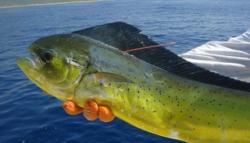
The American Fishing Tackle Co. released an update on a Dolphinfish Research Program study in South Carolina that it supports.
Even with a marginal improvement of fishing in May, the fishing fell short of the catch rate for the three-month period of May, June, and July observed in 2014. The overall average number of fish caught per trip this year was 15.7 percent lower than noted for the same period in 2014.
There was a 40.3 percent increase in the number of fishing trips surveyed this year, but that does not necessarily mean more fishing efforts took place because the weather was less stable earlier in the season.
Comparing the studies between 2014 and 2015 that observed harvests of the dolphinfish in May around Charleston, S.C., prompted "a near-uniform perception from participating anglers that dolphin fishing was way off from last year," AFTCO said.
"While more dolphins were documented being caught May-July in 2015, 1,183 fish in 2015 versus 1,000 fish in 2014, equated a 40.3 percent increase in the recorded fishing efforts of 2015, masking the decline in catch rates. In comparison of the July catch rates for the two years indicated, an even sharper drop of the number of fish caught per trip in 2015 from 2014 is 68.1 percent," wrote Stuart Clark, a Texas A&M University senior pursuing a bachelor's degree in aquatic ecology and conservation.
However, commercial fishermen met their dolphinfish quota for the first time, leading Clark to believe it might have been location, not lack of abundance, that contributed to the drop.
"The fact that these commercial vessels had unusually good catches of dolphin this year indicates there was an increased abundance of dolphin on the eastern side of the stream," Clark argued.
Despite the disappointment of anglers from Charleston to the Florida Keys, Clark believes the dolphinfish, which migrate more than 5,000 miles, were simply following their food supply.
"At this time, I believe the 16 percent decline observed in the 2015 overall recreational fishery in South Carolina was likely caused by a shift in the migratory path to the eastern side of the Gulf Stream," he wrote. "If a further decline is noted in the 2016 dolphin fishery, then I would have greater concern about the health of the stocks."
Even with a marginal improvement of fishing in May, the fishing fell short of the catch rate for the three-month period of May, June, and July observed in 2014. The overall average number of fish caught per trip this year was 15.7 percent lower than noted for the same period in 2014.
There was a 40.3 percent increase in the number of fishing trips surveyed this year, but that does not necessarily mean more fishing efforts took place because the weather was less stable earlier in the season.
Comparing the studies between 2014 and 2015 that observed harvests of the dolphinfish in May around Charleston, S.C., prompted "a near-uniform perception from participating anglers that dolphin fishing was way off from last year," AFTCO said.
"While more dolphins were documented being caught May-July in 2015, 1,183 fish in 2015 versus 1,000 fish in 2014, equated a 40.3 percent increase in the recorded fishing efforts of 2015, masking the decline in catch rates. In comparison of the July catch rates for the two years indicated, an even sharper drop of the number of fish caught per trip in 2015 from 2014 is 68.1 percent," wrote Stuart Clark, a Texas A&M University senior pursuing a bachelor's degree in aquatic ecology and conservation.
However, commercial fishermen met their dolphinfish quota for the first time, leading Clark to believe it might have been location, not lack of abundance, that contributed to the drop.
"The fact that these commercial vessels had unusually good catches of dolphin this year indicates there was an increased abundance of dolphin on the eastern side of the stream," Clark argued.
Despite the disappointment of anglers from Charleston to the Florida Keys, Clark believes the dolphinfish, which migrate more than 5,000 miles, were simply following their food supply.
"At this time, I believe the 16 percent decline observed in the 2015 overall recreational fishery in South Carolina was likely caused by a shift in the migratory path to the eastern side of the Gulf Stream," he wrote. "If a further decline is noted in the 2016 dolphin fishery, then I would have greater concern about the health of the stocks."


 Advertising
Advertising